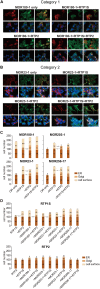Receptor-transporting protein (RTP) family members play divergent roles in the functional expression of odorant receptors
- PMID: 28586385
- PMCID: PMC5460901
- DOI: 10.1371/journal.pone.0179067
Receptor-transporting protein (RTP) family members play divergent roles in the functional expression of odorant receptors
Abstract
Receptor transporting protein (RTP) family members, RTP1S and RTP2, are accessory proteins to mammalian odorant receptors (ORs). They are expressed in the olfactory sensory neurons and facilitate OR trafficking to the cell-surface membrane and ligand-induced responses in heterologous cells. We previously identified different domains in RTP1S that are important for different stages of OR trafficking, odorant-mediated responses, and interaction with ORs. However, the exact roles of RTP2 and the significance of the requirement of the seemingly redundant co-expression of the two RTP proteins in vivo have received less attention in the past. Here we attempted to dissect the functional differences between RTP1S and RTP2 using a HEK293T cell-based OR heterologous expression system. When a set of 24 ORs were tested against 28 cognate ligands, unlike RTP1S, which always showed a robust ability to support odorant-mediated responses, RTP2 had little or no effect on OR responses and exhibited a suppressive effect over that of RTP1S for a subset of the ORs tested. RTP1S and RTP2 showed no significant difference in OR ligand selectivity and co-transfection with RTP2 increased the detection threshold for some ORs. A protein-protein interaction analysis showed positive interactions among OR, RTP1S, and RTP2, corroborating the functional linkages among the three molecules. Finally, further cell-surface and permeabilized immunocytochemical studies revealed that OR and the co-expressed RTP1S proteins were retained in the Golgi when co-transfected with RTP2, indicating that RTP1S and RTP2 could play different roles in the OR trafficking process. By examining the functional differentiations between the two RTP family members, we provided a molecular level explanation to the suppressive effect exerted by RTP2, shedding light on the divergent mechanisms underlying the RTP proteins in regulating the functional expression of ORs.
Conflict of interest statement
Figures




Similar articles
-
Receptor-transporting protein 1 short (RTP1S) mediates translocation and activation of odorant receptors by acting through multiple steps.J Biol Chem. 2012 Jun 22;287(26):22287-94. doi: 10.1074/jbc.M112.345884. Epub 2012 May 8. J Biol Chem. 2012. PMID: 22570474 Free PMC article.
-
RTP family members induce functional expression of mammalian odorant receptors.Cell. 2004 Nov 24;119(5):679-91. doi: 10.1016/j.cell.2004.11.021. Cell. 2004. PMID: 15550249
-
The N-terminal region of RTP1S plays important roles in dimer formation and odorant receptor-trafficking.J Biol Chem. 2019 Oct 4;294(40):14661-14673. doi: 10.1074/jbc.RA118.007110. Epub 2019 Aug 8. J Biol Chem. 2019. PMID: 31395660 Free PMC article.
-
RAMP like proteins : RTP and REEP family of proteins.Adv Exp Med Biol. 2012;744:75-86. doi: 10.1007/978-1-4614-2364-5_7. Adv Exp Med Biol. 2012. PMID: 22434109 Review.
-
Deorphanizing vertebrate olfactory receptors: recent advances in odorant-response assays.Neurochem Int. 2007 Jul-Sep;51(2-4):132-9. doi: 10.1016/j.neuint.2007.05.020. Epub 2007 Jun 13. Neurochem Int. 2007. PMID: 17640771 Review.
Cited by
-
Interactions among key residues regulate mammalian odorant receptor trafficking.FASEB J. 2022 Jul;36(7):e22384. doi: 10.1096/fj.202200116RR. FASEB J. 2022. PMID: 35639289 Free PMC article.
-
Hot Spot Mutagenesis Improves the Functional Expression of Unique Mammalian Odorant Receptors.Int J Mol Sci. 2021 Dec 28;23(1):277. doi: 10.3390/ijms23010277. Int J Mol Sci. 2021. PMID: 35008703 Free PMC article.
-
Identification of an LPS-Induced Chemo-Attractive Peptide from Ciona robusta.Mar Drugs. 2020 Apr 12;18(4):209. doi: 10.3390/md18040209. Mar Drugs. 2020. PMID: 32290587 Free PMC article.
-
Elucidating the Interactome of G Protein-Coupled Receptors and Receptor Activity-Modifying Proteins.Pharmacol Rev. 2023 Jan;75(1):1-34. doi: 10.1124/pharmrev.120.000180. Epub 2022 Dec 8. Pharmacol Rev. 2023. PMID: 36757898 Free PMC article. Review.
-
Functional-genomic analysis reveals intraspecies diversification of antiviral receptor transporter proteins in Xenopus laevis.PLoS Genet. 2021 May 20;17(5):e1009578. doi: 10.1371/journal.pgen.1009578. eCollection 2021 May. PLoS Genet. 2021. PMID: 34014925 Free PMC article.
References
-
- Buck L, Axel R. A novel multigene family may encode odorant receptors: a molecular basis for odor recognition. Cell. 1991;65(1):175–87. - PubMed
-
- Shepherd GM. Discrimination of molecular signals by the olfactory receptor neuron. Neuron. 1994;13(4):771–90. - PubMed
-
- Firestein S. How the olfactory system makes sense of scents. Nature. 2001;413(6852):211–8. doi: 10.1038/35093026 - DOI - PubMed
-
- Matsunami H, Buck LB. A multigene family encoding a diverse array of putative pheromone receptors in mammals. Cell. 1997;90(4):775–84. - PubMed
-
- Matsunami H, Montmayeur JP, Buck LB. A family of candidate taste receptors in human and mouse. Nature. 2000;404(6778):601–4. doi: 10.1038/35007072 - DOI - PubMed
MeSH terms
Substances
LinkOut - more resources
Full Text Sources
Other Literature Sources
Molecular Biology Databases
Miscellaneous

